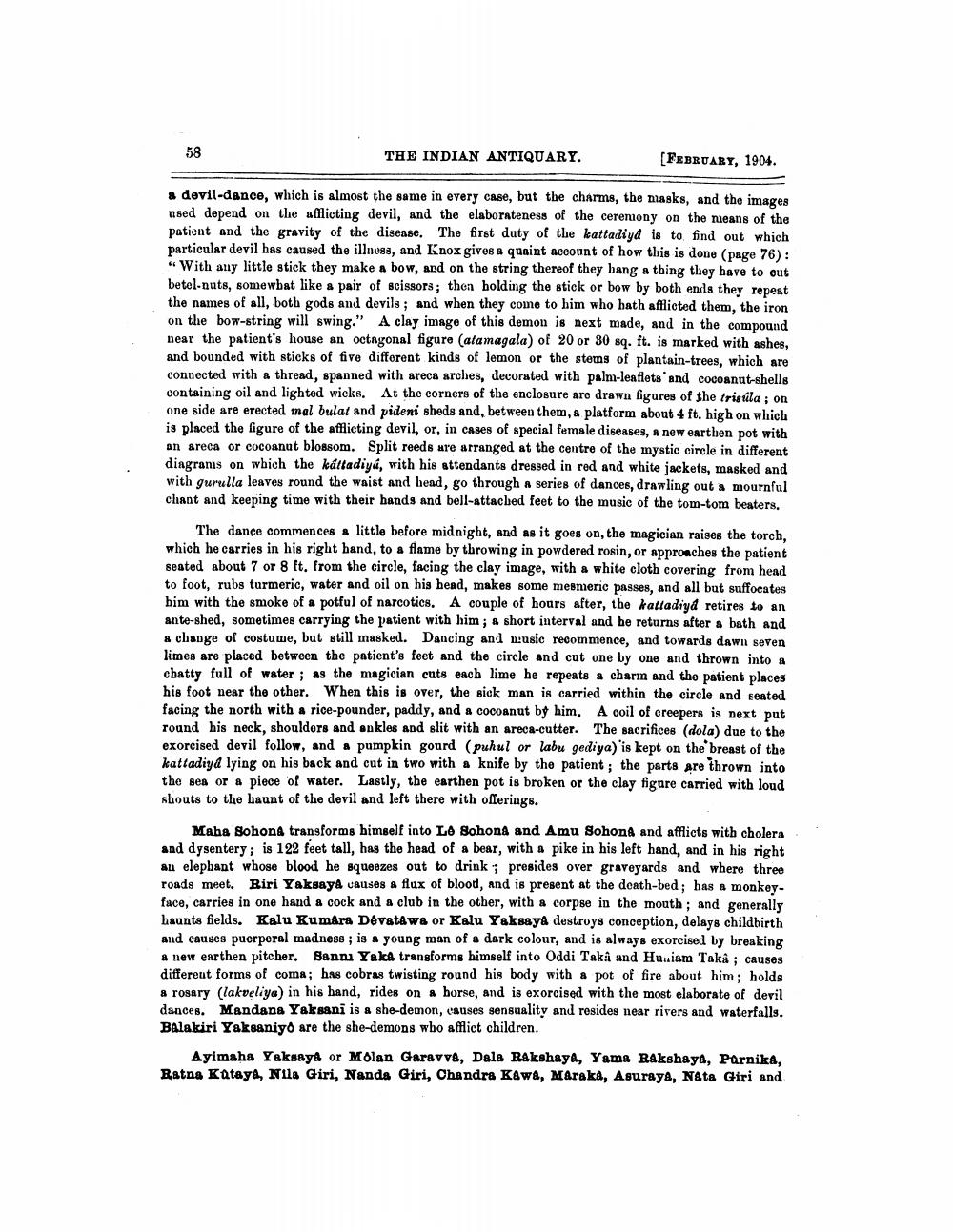________________
58
THE INDIAN ANTIQUARY.
[FEBRUARY, 1904.
a devil-dance, which is almost the same in every case, but the charms, the masks, and the images nsed depend on the afflicting devil, and the elaborateness of the ceremony on the neans of the patient and the gravity of the disease. The first duty of the kattadiya is to find out which particular devil has caused the illness, and Knox gives a quaint account of how this is done (page 76): "With any little stick they make a bow, and on the string thereof they bang a thing they have to cut betel nuts, somewhat like a pair of scissors; then holding the stick or bow by both ends they repeat the names of all, both gods and devils ; and when they come to him who hath afflicted them, the iron on the bow-string will swing." A clay image of this demon is next made, and in the compound near the patient's house an octagonal figure (alamagala) of 20 or 30 sq. ft. is marked with ashes, and bounded with sticks of five difforent kinds of lemon or the stems of plantain-trees, which are connected with a thread, spanned with areca arches, decorated with palm-leaflets and cocoanut-shells containing oil and lighted wicks. At the corners of the enclosure are drawn figures of the tristila; on one side are erected mal bulat and pideni sheds and, between them, a platform about 4 ft. high on which is placed the figure of the afflicting devil, or, in cases of special female diseases, a new earthen pot with an areca or cocoanut blossom. Split reeds are arranged at the centre of the mystic circle in different diagrams on wbich the kättadiya, with his attendants dressed in red and white jackets, masked and with gurulla leaves round the waist and head, go through a series of dances, drawling out a mournful chant and keeping time with their hands and bell-attached feet to the music of the tom-tom beaters.
The dance commences a little before midnight, and as it goes on, the magician raises the torch, which he carries in his right hand, to a flame by throwing in powdered rosin, or approaches the patient seated about 7 or 8 ft. from the circle, facing the clay image, with a white cloth covering from head to foot, rubs turmeric, water and oil on his head, makes some mesmeric passes, and all but suffocates him with the smoke of a potful of narcotics. A couple of hours after, the kattadiyd retires to an ante-shed, sometimes carrying the patient with him; a short interval and be returns after a bath and a change of costume, but still masked. Dancing and music recommence, and towards dawn seven limes are placed between the patient's feet and the circle and cut one by one and thrown into a cbatty full of water; as the magician cuts each lime he repeats a charm and the patient places his foot near the other. When this is over, the sick man is carried within the circle and seated facing the north with a rice-pounder, paddy, and a cocoanut by him. A coil of creepers is next put round his neck, shoulders and ankles and slit with an areca-cutter. The sacrifices (dola) due to the exorcised devil follow, and a pumpkin gourd (puhul or labu gediya) is kept on the breast of the kattadiya lying on his back and cut in two with a knife by the patient; the parts are thrown into the sea or a piece of water. Lastly, the earthen pot is broken or the clay figure carried with loud shouts to the baunt of the devil and left there with offerings.
Maha Sohona transforms himself into Le Sohond and Amu SohonA and afflicts with cholera and dysentery; is 122 feet tall, has the head of a bear, with a pike in his left hand, and in his right an elephant whose blood he squeezes out to drink ; presides over graveyards and where three roads meet. Biri Yaksaya causes a flux of blood, and is present at the death-bed; has a monkeyface, carries in one hand a cock and a club in the other, with a corpse in the mouth ; and generally haunts fields. Kalu Kumara Devatawa or Kalu Yaksaya destroys conception, delays childbirth and causes puerperal madness; is a young man of a dark colour, and is always exorcised by breaking a new earthen pitcher. Sannı Yaka transforms himself into Oddi Takî and Huuiam Takå; causes different forms of coma; has cobras twisting round his body with a pot of fire about him; holds a rosary (lakveliya) in his hand, rides on a borse, and is exorcised with the most elaborate of devil dances. Mandana Yaksani is a she-demon, causes sensuality and resides near rivers and waterfalls. BAlakiri Yakeaniyo are the she-demons who afflict children.
Ayimaha Yaksaya or Molan Garavve, Dala Rakshaya, Yama Rakshaya, Parnika, Ratna Kataya, Nila Giri, Nanda Giri, Chandra Kawa, Maraka, Asuraya, Nata Giri and




